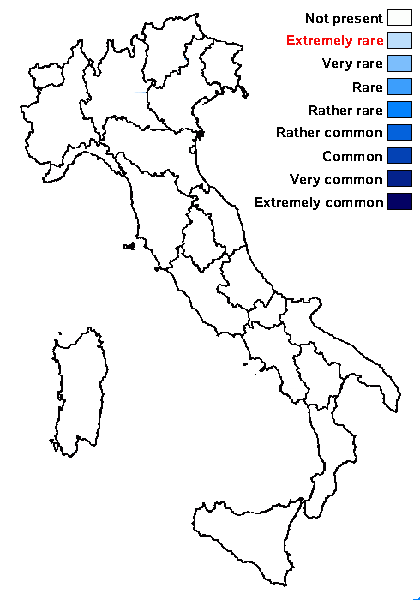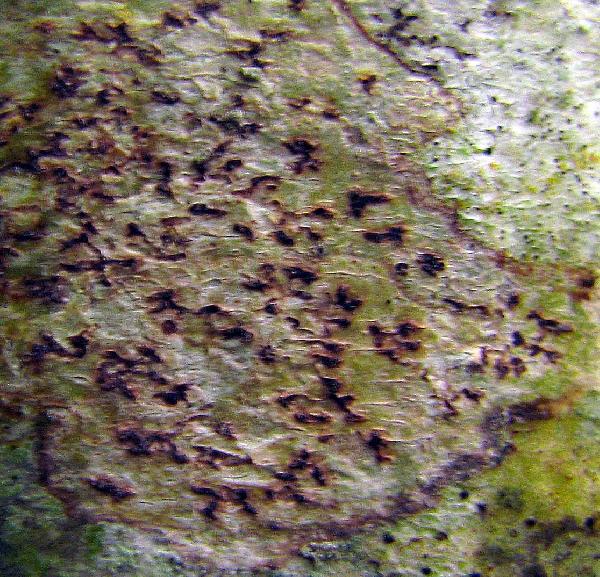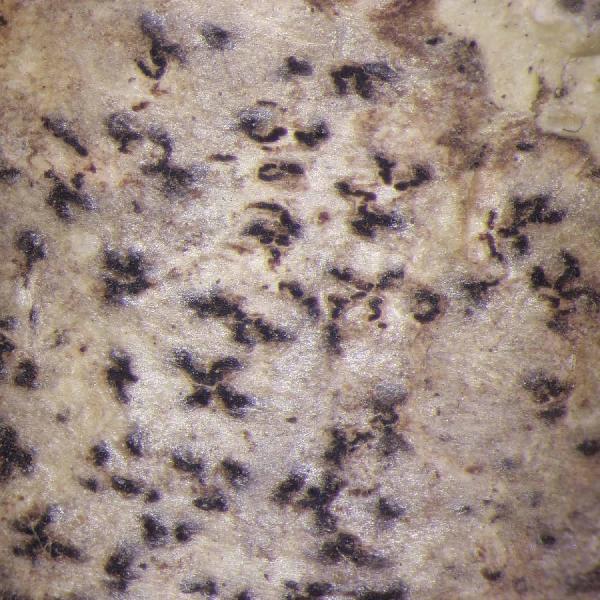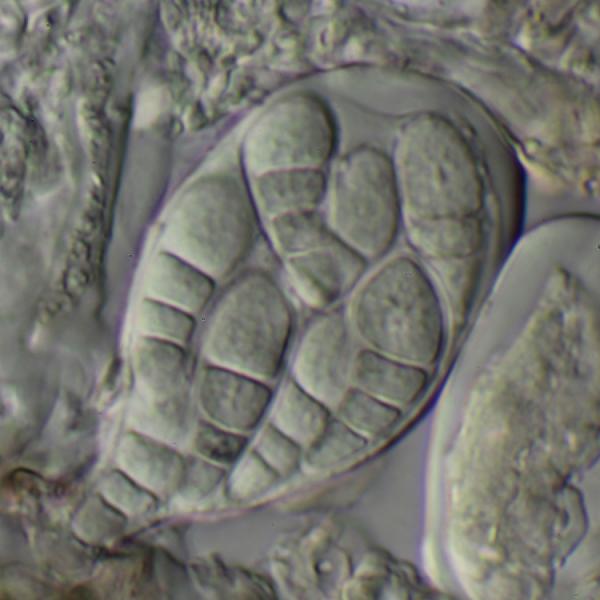Coniocarpon cuspidans (Nyl.) Moen, Frisch & Grube
in Frisch & al., MycoKeys, 62: 41, 2020.. Basionym: Arthonia cinnabarina f. cuspidans Nyl. - Flora, Regensburg, 59: 310, 1876.
Synonyms:
Distribution:
Description: Thallus crustose, endosubstratic or thinly episubstratic, sometimes evanescent, dirty orange, ochraceous or whitish, sometimes delimited by an orange-violet prothallus. Apothecia arthonioid, very variable in shape, from ellipsoid to weakly lirelliform, often confluent into stellate groups, 0.2-0.6 x 0.1-0.2 mm, with a dark reddish brown to brown-black, sometimes thinly white-pruinose disc, lacking an orange-red-pruina. Proper exciple poorly developed, brown, 7-20 μm wide, of 1-2 μm thick, vertically oriented, paraphysoid-like hyphae sometimes forming up to 16 μm long hairs at the outer margin, amyloid, with red or purple crystals soluble in K; epithecium yellowish brown, 8-20 μm high, with red or purple crystals soluble in K and K+ purple, composed of the branched tips of the paraphysoids extending horizontally above the asci, amyloid; hymenium colourless to yellowish red, 40-50 μm high, K-, hemiamyloid, I+ red, K/I+ blue; paraphysoids 1-2 μm thick, conglutinated only in lower parts, the branched tips 3(-4) μm wide, extending horizontally above the asci; hypothecium poorly developed, 10-25 µm high, colourless to pale yellowish brown, hemiamyloid. Asci 8-spored, long-opyriform to clavate, semi-fissitunicate, with a large apical dome and a distinct ocular chamber, without an hemiamyloid ring in the tholus, approaching the Arthonia-type. Ascospores (2-)3(-4)-septate, hyaline turning pale brown-when overmature, oblong-ovoid, with a larger cell at one apex, (15-)16-18(-20) x (6-)7-8(-9) μm. Photobiont trentepohlioid. Spot tests: thallus K-, C-, KC-, P-. Chemistry: thallus without lichen substances; apothecia with different quinoid pigments.Note: similar to C. fallax, but apothecia epruinose and ascospores slightly smaller. Never reported from Italy, but probably previously identified as C. fallax.
Growth form: Crustose
Substrata: bark
Photobiont: Trentepohlia
Reproductive strategy: mainly sexual

Predictive model

Photo uploaded by P. Cannon CC BY-NC - Source: https://fungi.myspecies.info/all-fungi/coniocarpon-cuspidans
On bark of Corylus avellana. Collection from Skye, Scotland.

Photo uploaded by P. Cannon CC BY-NC - Source: https://fungi.myspecies.info/all-fungi/coniocarpon-cuspidans
thallus on unidentified bark, VC47 Montgomery [historical dried preserved specimen].

Photo uploaded by P. Cannon CC BY-NC - Source: https://fungi.myspecies.info/all-fungi/coniocarpon-cuspidans
thallus on unidentified bark, VC47 Montgomery [historical dried preserved specimen].

CC BY-4.0 - Source:Frisch A, Moen VS, Grube M, Bendiksby M (2020) Integrative taxonomy confirms three species of Coniocarpon (Arthoniaceae) in Norway. MycoKeys 62: 27-51. https://doi.org/10.3897/mycokeys.62.48480
Coniocarpon cuspidans (TRH-L-29022) Scale bar: 1 mm
Growth form: Crustose
Substrata: bark
Photobiont: Trentepohlia
Reproductive strategy: mainly sexual

Predictive model

Photo uploaded by P. Cannon CC BY-NC - Source: https://fungi.myspecies.info/all-fungi/coniocarpon-cuspidans
On bark of Corylus avellana. Collection from Skye, Scotland.

Photo uploaded by P. Cannon CC BY-NC - Source: https://fungi.myspecies.info/all-fungi/coniocarpon-cuspidans
thallus on unidentified bark, VC47 Montgomery [historical dried preserved specimen].

Photo uploaded by P. Cannon CC BY-NC - Source: https://fungi.myspecies.info/all-fungi/coniocarpon-cuspidans
thallus on unidentified bark, VC47 Montgomery [historical dried preserved specimen].

 INDEX FUNGORUM
INDEX FUNGORUM
 GBIF
GBIF



